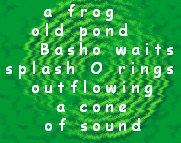
Home Page The Haiku Variations Mental conditions
Let’s face it—the haiku goes on too long—one can be bored by the tenth syllable, sigh—still another seven to struggle through. In this sound-bite generation it just calls for too much concentrated effort.
And what is so great about the syllable anyway? It plays no real part in the history of English verse—it can be long, short or flicker, quantum like, in and out of existence. Not, surely, a suitable building block for great truths.
It was in response to these pressures that the Great Master brought a new child into the world. The unit is not the syllable but the character, still operating within the sacred 5–7–5 structure. He calls it the tichiku. In the classical tichiku only a–z and standard punctuation are permitted.
The first tichiku to be written was self referencing:
Haiku?
Aye, I try
—A no no?
The haiku sandwich (or, as he now prefers to call it, the haiku mirror) proves possible:
Alone
No money
—A loan!
With the creative rapture of an artist discovering a new colour, many more followed—the quality rake then cleared the weeds and moss and left those given below:
‘A’ Road
Dead cat
So sad
No sun
—So no use
My hat
Try PC
—No mouse!
My cat?
No bus
Walking
I go on
In this minimalist world one will meet, perhaps often, the cat, the owl, a frog, at a pinch a swallow—but never a cormorant. The sum of all good and possible tichiku is interestingly finite. A fruitful subset ends with a sound effect:
Aim, MP
A bad egg
Splat!
And, after Basho
A frog
Old pond
Splsh
And, in the Master’s view, the best tichiku yet:
Waves
Shingle
Shrrr
The haiku, the tichiku and now, in the search for yet more minimalist verse forms, meet the triku. The unit for the triku is not syllables or characters but words. Three words, where the middle word has an -ing ending. As the examples show, the rules can be bent where the result seems to justify it. Though the name is original, the first examples were encountered on the Ai Li web-site.
Snail reading epitaph
Addicts sharing razors
The scope is large and also illustrates the deep ambiguities in the language. Listen to these:
Very boring triku (self reference)
No fucking swearing (built in contradiction)
Insect eating plant (balanced paradox)
Long boring tunnel (mid word pun)
Child keeping mum (two word pun)
Man eating tiger (sort of reversible)
Ape copying parrot (recursive paradox)
Some more:
Near Dorking, Redhill
Slowly walking dog
Dog barking mad
Please darling, DON’T!
Trees leaving off
Silencer going ______
One can do mirrors:
Love making love
Photo-copying photo
Porter drinking porter
Here are two topical ones
J K Rowling in-it
Railtrack rerailing failing
The adverbial ending leads to a ‘joke family’:
McFatty drinking heavily
Snorer sleeping soundly
Dyslexic writing baldy
Lawn mowing lackadaisically
But doesn’t have to:
Mercy killing—nicely
Bedside waiting—hopefully
Some earlier haiku will compress:
Millionaire grieving goldfish
Pond splashing—Frog!
As with haiku, one can get a Zen like quality:
One clapping hand
Future going past
Human being me
Poetic ones are more difficult. So far:
Armourer smelting ploughshares
Old moon, gathering dust
Water rippling sandstone
And from a disciple:
Plumbline sounding deep
A triku haiku
tale
Appears in the Frog grove
of Bonsai Forest
Meet the Tichigram!

Note how the old pond and the water are horizontal and the frog and sound vertical
Believe it or not—it has 17 characters!

The same subject, the traditional 17 syllables, but ‘rebalanced’ around 7 lines and a 4–9–4 structure. The central O is the event—before it the setting, after it the consequences. And the line of o’s? Bubbles perhaps, or even the constant nothing in a changing world of something…
There are 8 ways of symmetrically balancing 17 syllables over 3 lines. The 5-7-5 haiku and the 4–9–4, previously introduced, occupy the central positions. This is a brief visit to the outer regions. Clearly ‘the haiku effect’ will be lost but other effects may exist which can be presented to the world. A first look suggests that, as shown on the 4–9–4, secondary breaks which lift the 3-line limit or exploit graphical effects are features of this new landscape. Here are two examples—still in the milieu of herpetological limnodynamics.
A frog
Leaps into an old pond and the splashous outcome is
A sound
Hmmm. But here the 13 syllables natually break into 6–1–6, so much better is:
A FROG
leaps into an old pond
AND
the splashous outcome is
A SOUND
Which seems valid. Not a stunner, but quite attractive.
Now, at the other extreme:
Old pond, a leap; old pool, a hop
Frog
Making a splash, making a sound
Here we have even number rhythms and symmetries that the ‘all prime’ haiku denies us. Here is just one layout suggestion:
|
Old pond, a leap |
Old pool, a hop |
|
|
FROG |
||
|
Making a splash |
Making a sound |
Read it out loud. It seems to work.
